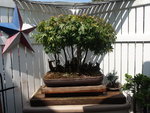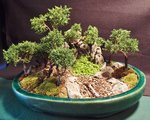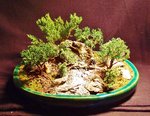In which case you could employ a soil buildup of 1 1/2" to 2" above your Drainage layer (to accomadate the roots),
Try to be specific when Watering,,, like just around the Tree Trunks as opposed to just Dousing or Spraying the entire planting...
I believe this is the idea I’m speaking to... With bonsai substrate we seek to achieve uniform particle hydration and aeration wich often requires extended and/or repeated watering periods (especially in my zone) followed by adequate drainage.
I like these ideas, they are what I’m trying to wrap my head around while troubleshooting in advance. But I still find potential pitfalls.
1. Substrate buildup above a ‘drainage layer’ of more coarse materials still doesn’t actually have drainage. I’m imaging rocks below substrate. The water will still settle in the rocks, not draining. The roots will eventually grow into lowest layer and possibly rot.
2. I agree that foliage watering could be counterproductive. The idea of specific watering has me scratching my head. I’m imagining lightly watering around the trunks while attempting to not use high volumes of water. The water trickles through that area of substrate, leaving many particles/ pockets dry and ultimately resulting in a water layer below that hasn’t drained.
It seems like a tedious task. I commend your patience.
It seems like drilling holes is the way to go. Or tilting.
The other obvious option will be using a stone slab and altering that accordingly... I’m interested in the clean aesthetics of the tray, hence the thread.
Have you tried leaving routes and areas for water to settle in the landscape away from the plants?
Here’s a pic of what I’m working towards. I don’t plan on having so much void space on the tray.











